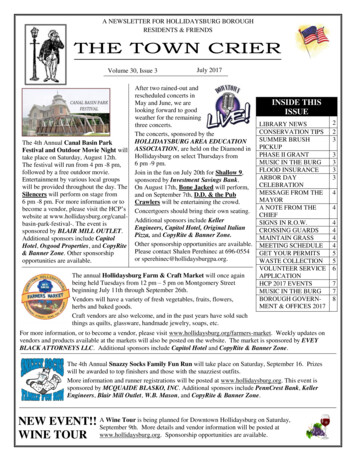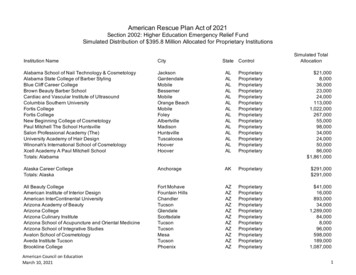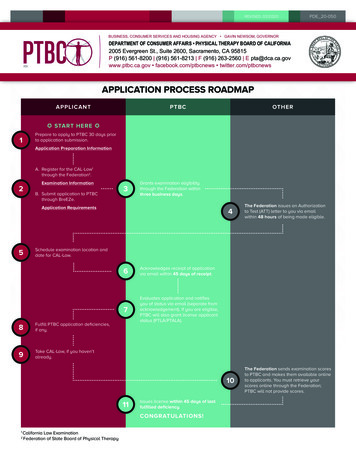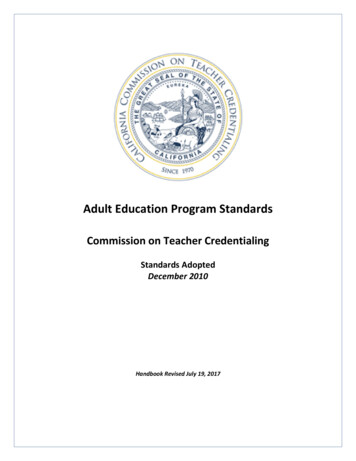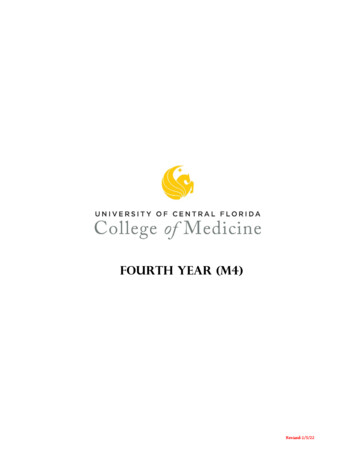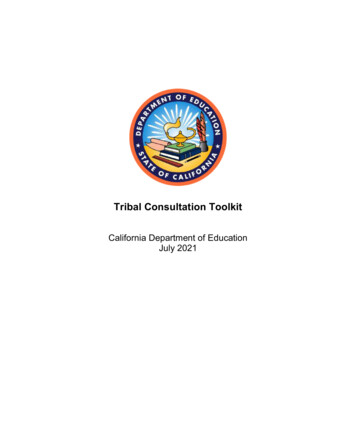
Transcription
Tribal Consultation ToolkitCalifornia Department of EducationJuly 2021
Tribal Consultation IntroductionTribal consultation is required under the Elementary and Secondary Education Act (ESEA)as reauthorized by the Every Student Succeeds Acts (ESSA). Tribal consultation is a formalprocess between tribal representatives and local educational agencies (LEAs) that servesthe American Indian/Alaska Native (Native American) population. The consultation processis critical to meeting the needs of California’s Native American students. Tribal consultationwas established to bring in and promote tribal voices on challenges affecting their children’seducation. The federal trust responsibility, upheld by the Supreme Court, places theresponsibility for meaningful consultation on federal agencies. This is reflected in the ESEAsection 1111(a)(1)(A) which states that State educational agencies are required to conducttimely and meaningful consultation with Indian tribes, among other entities, prior tosubmitting their State plan. Tribal consultation recognizes the role of tribal governments assovereigns in directing the education of Native American students and the teamwork neededbetween schools and tribal communities to facilitate a child’s academic progress andsuccess.DEFINITIONSConsultation – Meaningful and timely dialogue with appropriate officials andrepresentatives of tribal governments. Consultation emphasizes trust, respect, andshared responsibility, which requires the open exchange of information, full and candidexpression of mutual views, and a commitment to fully consider other views duringdecision making. Consultation should lead to mutual understanding.Government-to-Government Relationship – The term was first used by Indian Tribes andthe Federal Government, and is grounded in federal treaties, statutes and executiveorders. It is also used to describe the relationship between Indian Tribes and StateGovernments.Indian Tribe – A federally-recognized American Indian Tribe, Alaska Native Tribe, Band,Nation, Pueblo, Village or Community with whom the Federal Government maintains anofficial government-to-government relationship, established by a federal treaty, statute,executive order, court order or a federal administrative action is considered a federallyrecognized Tribe. The Bureau of Indian Affairs maintains and regularly publishes the listof Federally Recognized Tribes ory/).Sovereignty – The ultimate source of political power from which all specific politicalpowers are derived.Tribal Government – A governing body of a Native American Tribe, Band, Nation,Pueblo, Village or Community that the Secretary of the Interior acknowledges to exist asan Indian Tribe pursuant to the Federally Recognized Indian Tribe List Act of 1994,25 USC 479a.Tribal Leader – A tribal president, governor, chairperson, and/or elected or appointedrepresentative of an Indian Tribe.
Tribal Self-Governance – The governmental actions of Indian Tribes exercising selfgovernment and self-determination.Requirement for Tribal ConsultationAll districts receiving Title VI Indian Education Grant Awards of more than 40,000, or havea Native American student population of over 50 percent must engage in tribal consultation(ESEA section 1111(a)(1)(A)). Tribal consultation is required for all Title programs coveredby ESSA, not solely Title VI – Indian Education. Beginning with fiscal year 2017, affectedLEAs must consult with Indian tribes, or those tribal organizations approved by the tribeslocated in the area served by the LEA before submitting plans or applications for thefollowing programs under ESEA: Title I, Part A (Improving Basic Programs Operated by State and Local EducationAgencies) Title I, Part C (Education of Migratory Children) Title I, Part D (Prevention and Intervention Programs for Children and Youth who areNeglected, Delinquent, or At-Risk) Title II, Part A (Supporting Effective Instruction) Title III, Part A (English Language Acquisition, Language Enhancement, andAcademic Achievement Act) Title IV, Part A (Student Support and Academic Enrichment (SSAE) Grants) Title IV, Part B (21st Century Community Learning Centers [21st CCLC]) Title V, Part B, Subpart 2 (Rural and Low-Income School Program) Title VI, Part A, Subpart 1 (Indian Education Formula Grants to LEAs)It is the responsibility of the LEA to prepare and initiate tribal consultation. To ensure timelyand meaningful consultation on issues affecting Native American students, an affected LEAshall consult with tribal leaders from local Indian tribes or tribal organizations. Affecteddistricts, schools and their chosen representatives should begin the conversation with atribal nation near the school or district. This may be tribally-elected officials or tribaleducation directors, but it should be up to the tribes to choose who represents their voice inthe process of consultation. Tribal parents and local parent advisory committees should alsobe represented in the collaboration and consultation processes. Members or appropriateofficials will include, but are not limited to: tribal chairpersons, tribal councilmembers, tribaleducation coordinators/directors, and any others recommended by these tribalrepresentatives.Tribal consultation works best when time is allocated to build authentic trusting relationships.
It is important to understand there is no conventional approach to tribal consultation: it mustadapt to the needs of each Native American community, being aware of capacity and theneed for ongoing inclusion of tribal perspectives. When starting to plan for tribal consultation,it is critical to learn the history of tribal relations within the state and the community. Thisgoes beyond the basics of identifying tribes and tribal organizations and key issues, but to adeeper understanding of the community, the local Native American community, and thehistory they have with the state and the local education system. American Indian Tribeshave a unique political status that entitles them to a special government-to-governmentrelationship with the United States (U.S.) based on their federally-recognized status assovereign nations. This relationship extends to LEAs, as the LEA is representing federalprograms and federal funds. Formal tribal consultations and ongoing tribal communicationsare critical components of this relationship. Consultations promote the meaningful exchangeof ideas and information while building trusted relationships between the LEA and tribalgovernments.This process should incorporate reciprocal leadership at all stages. The invitation toparticipate should come from the local Superintendent and be addressed to tribal leaders. Itis the responsibility of the tribal government to designate their participants for the tribalconsultation process. This process will allow collaboration between the tribe and the districtto enhance the educational opportunities of Native American students. LEAs who start with agenuine commitment to consensus-based decision making, rooted in respect and knowledgeof Native American communities, have a real opportunity to change Native Americaneducation, in partnership with tribes and Native American communities.A list of the components of meaningful tribal consultation, many of which U.S. Department ofEducation (ED) has outlined in its “Consultation and Coordination with American Indian andAlaska Native Tribal Governments” /oie/tribalpolicyfinal.pdf): Consultation is meaningful when it occurs at the earliest possible stage, prior to thedevelopment of a program, initiative, or policy to ensure that tribal views areintegrated Tribal consultation is most effective when it is seen and understood as a process thatrequires continuous input and discussion Authentic consultation is based on open communication and coordination that activelyseeks and considers the views of all participants, and then seeks agreement on howto proceed The process of meaningful consultation is equally as important as the product ofconsultation. If tribal input is not reflected in how education programs and servicesare administered to Native American students, then we have missed a greatopportunity in supporting our nation’s most vulnerable youth Establishing a minimum set of requirements and expectations with respect toconsultation along with establishing measurable outcomes are necessities for
meaningful consultationConsultation is a cyclical process that incorporates the initial consultation, agreements,monitoring progress, reporting, and ongoing evaluation. The consultation process should notbe linear or stagnant. Effective and ongoing evaluation is critical as districts work to developand strengthen processes and policies to facilitate meaningful tribal consultation. Thisprocess offers a valuable tool to positively impact Native American students.Below are critical components of the consultation process that LEAs are encouraged toincorporate: Identify and contact participants. Tailor communication strategies to ensure that theappropriate method is used for the intended audience (for example, send printednotices via postal mail to tribal leaders to indicate a higher degree of formality) Establish a minimum set of requirements and expectations with respect toconsultation Establish measurable outcomes for meaningful consultation Ensure everyone involved understands the objectives of each meeting and thepurpose of consultation Establish dates for upcoming meetings, including tribal consultation meetings andinformation or input meetings that are open to the public Establish deadlines for plan development and submission Distribute and post information on proposed programs prior to the meeting Plan presentations about existing programs so that tribes have clarity regarding howthe programs operate in the local, district or state context Gather relevant data, both local and statewide from a variety of sources including:DataQuest (https://data1.cde.ca.gov/dataquest/), California School Dashboard andSystem of Support (https://www.cde.ca.gov/ta/ac/cm/) LEA Accountability ReportCard (https://www.cde.ca.gov/ta/ac/le/) for Native American students including but notlimited to:o Percent of 9th grade students on track for graduatingo Attendance and truancy datao Percent enrolled in Career & Technical Education opportunitieso Percent enrolled in college courses in high schoolo Number of disciplinary actions and push outs
o Number of students in after school programso Number of students in alternative educationo Number of students in extra-curricular activities (e.g., band, sports, debate)o Number of students with individualized education planso Number of students in Talented & Gifted programs Create submission process for tribal input Establish a notification system to make sure all parties are continually updated Establish a plan to distribute and post a final copy of plans or applications Establish a plan for subsequent years for meetings to review progress, makechanges, and incorporate feedback Distribute and post contact information for district personnel or members ofcommitteesEvaluate the tribal consultation process. Questions that should guide evaluation include: How was outreach conducted to reach groups or individuals whose views have nottraditionally been recognized? Was the information provided relevant, produced in plain language, and easy tounderstand? Are all consultations accessible and welcoming? Did all participants have the opportunity to add their value to the meeting? What kind of follow‐up was provided after the meeting? Did the consultation meeting change the relationship among participants?Federal Title ProgramsThe following is a list of programs, including program descriptions and California Departmentof Education (CDE) contact information, which require an affected LEA to consult with NativeAmerican tribes or tribal organizations prior to submitting plans or applications under ESEA.LEAs should conduct their consultation in advance of making significant decisions regardingplans or applications for covered programs, to ensure an “opportunity for tribalrepresentatives designated to consult on behalf of the tribe.
Title I, Part AImproving Basic Programs Operated by State and LEAsTitle I, Part A (https://www.cde.ca.gov/sp/sw/t1/) — Federal funds help to meet theeducational needs of students in California schools. Funds are used to support effective,evidence-based educational strategies that close the achievement gap and enable thestudents to meet the state's challenging academic standards. Title I-funded schools areeither Targeted Assistance Schools (TAS) or Schoolwide Program (SWP) schools.Authorized Use of FundsTitle I, Part A federal funds help to meet the educational needs of students in offunds.asp).The CDE recommends that LEAs, county offices of education, and direct funded charterschools consider the following general criteria when approving activities or expendituressupported with Title I, Part A funds: The activity/expenditure is aligned to meet the challenging State academic contentstandards (ESSA sections 1112[a][3][B][i] and 1112[b]); The activity/expenditure is an evidenced-based educational strategy (ESSA sections1003[b][1][B]; 1114[d]; and 1115[h]); The activity/expenditure is reasonable, necessary, and allocable cost to the program(2 CFR 200.404–200.405); Title I, Part A funds used supplement the funds that would, in the absence of suchfunds, be made available from State and local sources, and do not supplant suchfunds (ESSA Section 1118[b][1]); and Title I, Part A funds used are current Federal fiscal year or the subsequent fiscal year(ESSA Section 1127[a])Title I SWPs should consider the following general criteria when approving activities orexpenditures supported with Title I, Part A funds: The activity/expenditure meets a need identified in the comprehensive needsassessment (ESSA Section 1114[b][6]); The activity/expenditure is included in the Single Plan for Student Achievement(SPSA) (Education Code [EC] Section 64001[g][C][3]); The SPSA has been approved by the local governing board (EC Section 64001[i]); The School-site Council (SSC) annually evaluates and monitors the implementationof the SPSA and progress towards accomplishing the goals (EC Section
64001[g][2][B] and [i]); and The activity/expenditure has been reviewed, approved, and recommended by theSSC to the local governing board (EC Section 64001[d])Title I TASs should consider the following general criteria when approving activities orexpenditures supported with Title I, Part A funds: The activity/expenditure serves the needs of students that are identified as failing, ormost at risk of failing to meet challenging State academic standards on the basis ofmultiple, educational related, objective criteria established by the LEA andsupplemented by the school (ESSA Section 1115[c][1][B]) The activity/expenditure is included on an ongoing basis, review of the progress ofeligible children and revise the TAS program, if necessary, to provide additionalassistance, to enable such children to meet the challenging State academicstandards (ESSA Section 1115[b][G][iii]) Staff members paid with Title I funds may assume limited duties that are assigned tosimilar personnel who are not so paid, including duties beyond classroom instructionor that do not benefit participating children, so long as the amount of time spent onsuch duties is the same proportion of total work time as prevails with respect tosimilar personnel at the same school (ESSA Section 1115[d][2])The McKinney-Vento Homeless Assistance Act (Subtitle B – Education for HomelessChildren and Youth), reauthorized under ESSA, ensures educational rights and protectionsfor children and youth experiencing homelessness (42 U.S. Code [U.S.C.] Section 11434).This overview explains the legislation and offers strategies for implementing it. Homeless children are automatically eligible for Title I services, regardless of theircurrent academic performance (20 U.S.C. Section 6315[c][2][E]) LEAs must reserve funds, as necessary, to provide comparable services to homelessstudents regardless of their school of attendance (20 U.S.C. Section 6313[c][3][A]) Homeless students at non-Title I schools are entitled to academic supportcomparable to students attending Title I schools (20 U.S.C. Section 6313[c][3][C][i]) Title I does not have a formal definition of comparable services Only 15 percent of Title I funds can be carried over to the next year Title I, Part A reservation funds for homeless education can be used to supporthomeless students (20 U.S.C. Section 6315[c][2][E])If an expenditure/activity does not meet all of the above rationale, it is not likely to be anauthorized use of Title I, Part A funds.Contact the CDE’s Title I Policy, Program, and Support Office at TitleI@cde.ca.gov or byphone at 916-319-0917.
Title I, Part CEducation of Migratory ChildrenTitle I, Part C (https://www.cde.ca.gov/sp/me/mt/) — The purpose of the Migrant EducationProgram is to assist in supporting high quality and comprehensive educational programs andservices for migratory children during and beyond the school year and to help reduce theeducational disruptions and other problems that result from repeated moves.Authorized Use of Funds Identification and recruitment (ID & R) of migratory children (ages 3–21) Instructional and support services ID & R training Interstate and intrastate coordination Advocacy Family Engagement Migrant Student Records ExchangeContact the CDE’s Migrant Education Office at MMallory@cde.ca.gov or by phone at916-319-0851.
Title I, Part DPrevention and Intervention Programs for Children and Youth who are Neglected,Delinquent, or At-RiskTitle I, Part D (https://www.cde.ca.gov/sp/sw/pi/index.asp) — Subgrants to support theoperation of LEAs to provide educational programs that prepare children and youth forfurther education, employment training, and successful transition from a correctional facility.Funds are used to improve educational services that enable the students to meet the state'schallenging academic standards and provide successful transition from institutionalization tofurther schooling or employment (ESSA Section 1401).Title I, Part D, Subpart 1 t1.asp) —Subgrants for State Agencies (SAs) to provide a free public education for children and youthin institutions for neglected or delinquent children and youth attending community dayprograms for neglected or delinquent children and youth, or in adult correctional institutions.EligibilityThe SA Application for the Prevention and Intervention Programs for Children and YouthWho Are Neglected, Delinquent or At-Risk grant, also known as the Title I, Part D, Subpart 1program, is available to any California SA that is responsible for providing free publiceducation for children and youth: in institutions for neglected or delinquent children and youth; attending community day programs for neglected or delinquent children and youth; or in adult correctional institutionsPurposeAccording to ESSA Section 1401(a), the purposes of Title I, Part D, Subpart 1 is to:1. to improve educational services for children and youth in local and tribal Stateinstitutions for neglected or delinquent children and youth so that such children andyouth have the opportunity to meet the same challenging State academic standardsthat all children in the State are expected to meet;2. to provide such children and youth with the services needed to make a successfultransition from institutionalization to further schooling or employment; and3. to prevent at-risk youth from dropping out of school, and to provide dropouts, andchildren and youth returning from correctional facilities or institutions for neglected ordelinquent children and youth, with a support system to ensure their continuededucation and the involvement of their families and communitiesTitle I, Part D, Subpart 2 (https://www.cde.ca.gov/sp/sw/t1/nord.asp) — Subgrants for LEAs
to improve educational services for children and youth in local, tribal, and State institutionsfor neglected or delinquent children and youth so that such children and youth have theopportunity to meet the same challenging State academic standards.PurposeThe purpose of Subpart 2 is to support the operation of LEA programs that involvecollaboration with locally operated correctional facilities (ESSA Section 1421[1]-[3]): To carry out high quality education programs to prepare children and youth forsecondary school completion, training, employment, or further education; To provide activities to facilitate the transition of such children and youth from thecorrectional program to further education or employment; and To operate programs in local schools for children and youth returning fromcorrectional facilities, and programs which may serve at-risk children and youthContact Sherry Davis at SDavis@cde.ca.gov or by phone at 916-445-4904.
Title II, Part ASupporting Effective InstructionTitle II, Part A (https://www.cde.ca.gov/fg/aa/ca/titleii.asp) — A federal program thatincreases student academic achievement through strategies such as improving teacher andprincipal quality. Title II, Part A, Supporting Effective Instruction is a federal categoricalprogram contained in the Consolidated Application. The purpose of Title II, Part A is toincrease the academic achievement of all students by helping schools and districts:(1) improve teacher and principal quality through professional development and otheractivities, and (2) provide low-income and minority students greater access to effectiveteachers, principals, and other school leaders.PurposeThe purpose of Title II is to provide supplemental activities that strengthen the quality andeffectiveness of teachers, principals, and other school leaders which includes: Increasing student achievement consistent with the challenging state academicstandards; Improving the quality and effectiveness of teachers, principals, and other schoolleaders; Increasing the number of teachers, principals, and other school leaders who areeffective in improving student academic achievement in schools; and Providing low-income and minority students greater access to effective teachers,principals, and other school leadersTitle II, Part A can be used to improve teacher and principal quality, which includes inductionprograms, professional development and support of professional growth, equitable access toquality educators, and recruitment for hard-to-find educator positions. Title II, Part Aequitable services must be offered to eligible nonprofit private schools located within theLEA boundaries. LEAs must consult with participating private schools.Contact the CDE’s Educator Excellence and Equity Division Office by phone at916-323-6400. The Title II, Part A program contact is Lisa Fassett (LFassett@cde.ca.gov,916-323-4963) and the fiscal contact is the Categorical Allocations & Audit Resolution office(CAAR@cde.ca.gov).
Title III, Part ALanguage Instruction for English learners and Immigrant StudentsTitle III, Part A (https://www.cde.ca.gov/sp/el/t3/) — Language instruction for English learnerand immigrant students.PurposeThe purpose of the Title III Language Instruction for English learners and ImmigrantStudents program is to ensure that all English learners attain English language proficiency,develop high levels of academic attainment in English, and meet the same challenging stateacademic standards as all other students (20 U.S.C. §§1703(f), 6825(a).Authorized Uses of FundsFunds must be used for the following supplemental services as part of the languageinstruction program for English learners and immigrant children and youth: Developing and implementing new language instruction educational programs,academic content instructional programs including early childhood educationprograms, elementary school programs, secondary school programs, and dualenrollment programs Highly focused, innovative, locally-designed activities to expand or enhance existinglanguage instruction educational programs Implementing SWPs for restructuring, reforming, and upgrading language instructioneducational programs and academic content instruction Implementing agency-wide programs for restructuring, reforming, and upgradingprograms, activities relating to language instructional education programs andacademic content instructionContact the CDE’s Language Policy and Leadership Office by phone at 916-319-0845. TheTitle II, Part A program contact is Geoffrey Ndirangu (GNdirang@cde.ca.gov, 916-323-5831)and the fiscal contact is Cristina Echols Gollas (CEcholsgollas@cde.ca.gov, 916-323-5124).
Title IV, Part AStudent Support and Academic EnrichmentTitle IV, Part A (https://www.cde.ca.gov/sp/st/) — SSAE program federal funds are toimprove students’ academic achievement by increasing LEAs, schools, and localcommunities capacity.PurposeThe purpose of Title IV, Part A is to improve students’ academic achievement by increasingthe capacity of states, LEAs, schools, and local communities to1. provide all students with access to a well-rounded education;2. improve school conditions for student learning; and3. improve the use of technology in order to improve the academic achievement anddigital literacy of all studentsEligibilityTo qualify for Title IV, Part A funds, LEAs must (1) submit an application, known as the LocalControl and Accountability Plan Federal Addendum in California, to the State educationalagency; and (2) complete a needs assessment (ESSA Section 4106[a]).Contact Kevin Donnelly at TitleIV@cde.ca.gov, or by phone at 916-319-0942.
Title IV, Part B21st Century Community Learning CentersTitle IV, Part B ntschls.asp) — Thepurpose of the 21st CCLC program is to provide grants to local school districts andcommunity learning centers for afterschool programs serving students in low-performingschools.PurposeThe purpose of Title IV, Part B is to provide opportunities for communities to establish orexpand activities in community learning centers that:1. provide opportunities for academic enrichment, including providing tutorial services tohelp students, particularly students who attend low-performing schools, to meet Stateand local student academic achievement standards in core academic subjects, suchas reading and mathematics;2. offer students a broad array of additional services, programs, and activities, such asyouth development activities, drug and violence prevention programs, counselingprograms, art, music, and recreation programs, technology education programs, andcharacter education programs, that are designed to reinforce and complement theregular academic program of participating students; and3. offer families of students served by community learning centers opportunities forliteracy and related educational developmentContact the CDE’s Expanded Learning Division at ExpandedLearning@cde.ca.gov, or byphone at 916-319-0923.
Title V, Part B, Subpart 2Rural and Low-Income School ProgramTitle V, Part B, Subpart 2 (https://www.cde.ca.gov/fg/aa/rp/) —ESEA, reauthorized as ESSA,includes the Rural Education Achievement Program Initiative, designed to address theunique needs of rural school districts that frequently: (1) lack the personnel and resourcesneeded to compete effectively for federal competitive grants; and (2) receive formula grantallocations in amounts too small to be effective in meeting their intended purposes (ESSASection 5202). An LEA is eligible for the Rural and Low-Income Schools (RLIS) program if20 percent or more of the children served by the LEA are from families with incomes belowthe poverty line, and all of the schools served by the LEA are designated with a schoollocale code of 32, 33, 41, 42, or 43 by the National Center for Education Statistics (NCES)(ESSA Section 5221[b][1]).EligibilityAn LEA is eligible for RLIS if 20 percent or more of the children served by the LEA are fromfamilies with incomes below poverty, and all of the schools served by the LEA aredesignated with a school locale code of 32, 33, 41, 42, or 43 by the NCES (ESSA Section5221[b][1]).Current year RLIS allocations are based on an LEA’s student low income percentagereported two years before by the NCES.Authorized Uses of FundsAn LEA may use RLIS funds for the following activities (ESSA Section 5222[a]): Title I, Part A Title II, Part A Title III Title IV, Part A Parental involvement activitiesContact Patricia Ramirez at REAP@cde.ca.gov or by phone at 916-319-0787.
Title VI, Part A, Subpart 1Indian Education Formula Grants to LEAsTitle VI, Part A, Subpart 1 html) — It isthe policy of the U.S. to fulfill the Federal Government's unique and continuing relationshipwith and responsibility to the Indian people for the education of Indian children. The FederalGovernment will continue to work with LEAs, Indian tribes and organizations, postsecondaryinstitutions, and other entities toward the goal of ensuring that programs that serve Indianchildren are of the highest quality and provide for not only the basic elementary andsecondary educational needs, but also the unique educational and culturally relatedacademic needs of these children. It is further the policy of the U.S. to ensure that Indianchildren do not attend school in buildings that are dilapidated or deteriorating, which maynegatively affect the academic success of such children.PurposeIt is the purpose of this part to support the efforts of LEAs, Indian tribes and organizations,postsecondary institutions, and other entities:1. to meet the unique educational and culturally related academic needs of Indianstudents, so that such students can meet
programs and federal funds. Formal tribal consultations and ongoing tribal communications are critical components of this relationship. Consultations promote the meaningful exchange of ideas and information while building trusted relationships between the LEA and tribal governments. This process should incorporate reciprocal leadership at all .
